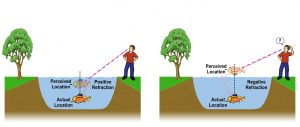This is a fact that we cannot see any object in a perfectly dark room conclusively establishes the truth that light is necessary for the purpose of vision. Nature has endowed us the eye(retina) with the sensitivity to detect electromagnetic waves. Light is an electromagnetic radiation(wave) belongs to the region of the spectrum (wavelength of about 400 nm to 700nm). In other words, human eye can detect(see) wavelength from 400 nm to 700 nm. There are two thing about light. First, the light travels with enormous speed of 2.99792458×10⁸ m/s in vacuum and second, that it travels in a straight line
There are seven basic properties of light
1). Reflection of light
2). Refraction of light
3). Diffraction of light
4). Interference of light
5). Polarisation of light
6). Dispersion of light
7). Scattering of light
In this blog we are about to study, the reflection of light
Reflection of light
When a ray of light passing through a medium is incident on the interface with another medium then, a portion of light returns to the first medium. This phenomenon is called reflection of light.
The surface from the reflection takes place is called the reflector.
Here the ray which is falling on the surface of reflector is called incident ray. The ray which returns back from the surface of reflector is known as the reflected ray. The perpendicular drawn at the point of incidence is known as normal. The angle between the incident ray and the normal is called the angle of incidence denoted by <i . The angle between the reflected ray and the normal is known as the angle of reflection denoted by <r.
Laws of reflection
Reflection of light obeys the following laws.
- The incident ray, the reflected ray and the normal to the refracting surface at the point of incidence lie on the same plane
- The angle of incidence is equal to angle of reflection
i.e. <i=<r
Factors on which the quantity of reflected light depends
A portion of light falling on the surface of separation returns to the first medium and some part of incident light is absorbed by the second medium. If the second medium is transparent or translucent than a portion of incident light penetrates into the second medium.
The amount of light which gets reflected depends upon
1). The nature of two media.
2). The angle at which light strikes a surface.
For example, when light is incident in air normally on an ordinary glass plate, 85 to 90% of light is reflected back into air. If incidence is not normal, greater percentages are reflected.

Types of reflection
Reflection can be two types depending on the nature of the surface of reflector.
- Regular reflection
- Irregular reflection or diffuse reflection
Regular reflection
If a parallel beam of rays is incident on a smooth plane reflector, then it is reflected wholly as a parallel beam. This type of reflection is called regular reflection .
This type of reflection occurs in the plane mirror, upper surface of undisturbed water, polished metal surface etc.
Irregular reflection or diffuse reflection
All beam of rays after reflection from a rough surface do not remain parallel more. Such type of reflection of light is called diffuse or irregular reflection.
Some phenomena of reflection
i) when light falls on a black body, practically no reflection takes place. The black body absorbs almost the whole incident light. On the other hand, white surface does not absorb any light .
ii) Twilight: Twilight is the time between dawn and sunrise and the time between sunset and dusk. The sun itself is not actually visible from this ground level because it is below the horizon. However, the suspended dust particle at upper atmosphere is still receive direct sun rays. Due to diffuse reflection, this light spreads in all direction and partially illuminates the ground.

Some applications of reflection of light
1) Inside of optical instruments like camera, telescope etc, are painted black in order to reduce unwanted reflection of light.
2) White screen is used in cinemas so that all the colours are reflected to the maximum extent and the image formed on it is very bright and distinct.
3) Reflection plays an important role to modern microscopes. Light is successively reflected from mirrors and at the same time it is magnified. Finally we are able to take a satisfactory magnification of the element we examine.










1stly thank you arsalan , your blog is so amezing , it is very helpful for my study
Thank you 💚
Very helpful for all the students
Thank you 💚